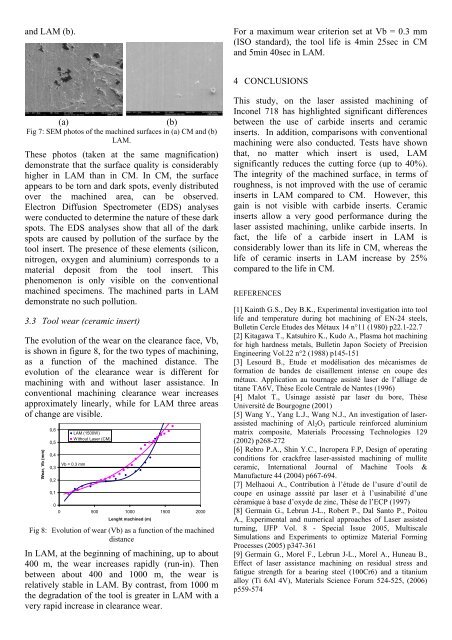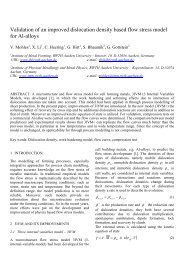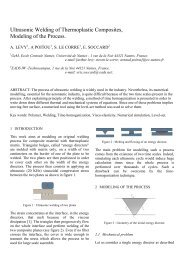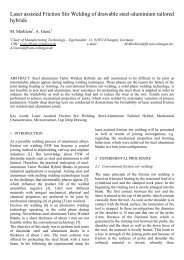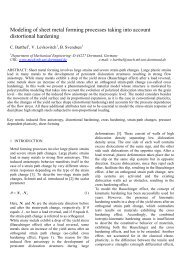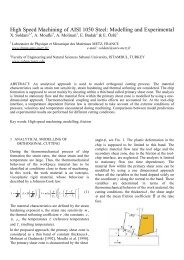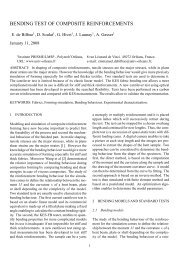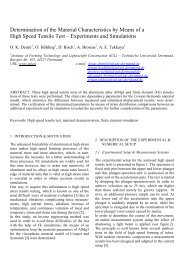Laser-assisted machining of Inconel 718 with carbide and ceramic ...
Laser-assisted machining of Inconel 718 with carbide and ceramic ...
Laser-assisted machining of Inconel 718 with carbide and ceramic ...
Create successful ePaper yourself
Turn your PDF publications into a flip-book with our unique Google optimized e-Paper software.
<strong>and</strong> LAM (b).For a maximum wear criterion set at Vb = 0.3 mm(ISO st<strong>and</strong>ard), the tool life is 4min 25sec in CM<strong>and</strong> 5min 40sec in LAM.4 CONCLUSIONS(a)(b)Fig 7: SEM photos <strong>of</strong> the machined surfaces in (a) CM <strong>and</strong> (b)LAM.These photos (taken at the same magnification)demonstrate that the surface quality is considerablyhigher in LAM than in CM. In CM, the surfaceappears to be torn <strong>and</strong> dark spots, evenly distributedover the machined area, can be observed.Electron Diffusion Spectrometer (EDS) analyseswere conducted to determine the nature <strong>of</strong> these darkspots. The EDS analyses show that all <strong>of</strong> the darkspots are caused by pollution <strong>of</strong> the surface by thetool insert. The presence <strong>of</strong> these elements (silicon,nitrogen, oxygen <strong>and</strong> aluminium) corresponds to amaterial deposit from the tool insert. Thisphenomenon is only visible on the conventionalmachined specimens. The machined parts in LAMdemonstrate no such pollution.3.3 Tool wear (<strong>ceramic</strong> insert)The evolution <strong>of</strong> the wear on the clearance face, Vb,is shown in figure 8, for the two types <strong>of</strong> <strong>machining</strong>,as a function <strong>of</strong> the machined distance. Theevolution <strong>of</strong> the clearance wear is different for<strong>machining</strong> <strong>with</strong> <strong>and</strong> <strong>with</strong>out laser assistance. Inconventional <strong>machining</strong> clearance wear increasesapproximately linearly, while for LAM three areas<strong>of</strong> change are visible.Wear, Vb (mm)0,60,50,40,30,20,1LAM (1500W)Without <strong>Laser</strong> (CM)Vb = 0.3 mm00 500 1000 1500 2000Lenght machined (m)Fig 8: Evolution <strong>of</strong> wear (Vb) as a function <strong>of</strong> the machineddistanceIn LAM, at the beginning <strong>of</strong> <strong>machining</strong>, up to about400 m, the wear increases rapidly (run-in). Thenbetween about 400 <strong>and</strong> 1000 m, the wear isrelatively stable in LAM. By contrast, from 1000 mthe degradation <strong>of</strong> the tool is greater in LAM <strong>with</strong> avery rapid increase in clearance wear.This study, on the laser <strong>assisted</strong> <strong>machining</strong> <strong>of</strong><strong>Inconel</strong> <strong>718</strong> has highlighted significant differencesbetween the use <strong>of</strong> <strong>carbide</strong> inserts <strong>and</strong> <strong>ceramic</strong>inserts. In addition, comparisons <strong>with</strong> conventional<strong>machining</strong> were also conducted. Tests have shownthat, no matter which insert is used, LAMsignificantly reduces the cutting force (up to 40%).The integrity <strong>of</strong> the machined surface, in terms <strong>of</strong>roughness, is not improved <strong>with</strong> the use <strong>of</strong> <strong>ceramic</strong>inserts in LAM compared to CM. However, thisgain is not visible <strong>with</strong> <strong>carbide</strong> inserts. Ceramicinserts allow a very good performance during thelaser <strong>assisted</strong> <strong>machining</strong>, unlike <strong>carbide</strong> inserts. Infact, the life <strong>of</strong> a <strong>carbide</strong> insert in LAM isconsiderably lower than its life in CM, whereas thelife <strong>of</strong> <strong>ceramic</strong> inserts in LAM increase by 25%compared to the life in CM.REFERENCES[1] Kainth G.S., Dey B.K., Experimental investigation into toollife <strong>and</strong> temperature during hot <strong>machining</strong> <strong>of</strong> EN-24 steels,Bulletin Cercle Etudes des Métaux 14 n°11 (1980) p22.1-22.7[2] Kitagawa T., Katsuhiro K., Kudo A., Plasma hot <strong>machining</strong>for high hardness metals, Bulletin Japon Society <strong>of</strong> PrecisionEngineering Vol.22 n°2 (1988) p145-151[3] Lesourd B., Etude et modélisation des mécanismes deformation de b<strong>and</strong>es de cisaillement intense en coupe desmétaux. Application au tournage assisté laser de l’alliage detitane TA6V, Thèse Ecole Centrale de Nantes (1996)[4] Malot T., Usinage assisté par laser du bore, ThèseUniversité de Bourgogne (2001)[5] Wang Y., Yang L.J., Wang N.J., An investigation <strong>of</strong> laser<strong>assisted</strong><strong>machining</strong> <strong>of</strong> Al 2 O 3 particule reinforced aluminiummatrix composite, Materials Processing Technologies 129(2002) p268-272[6] Rebro P.A., Shin Y.C., Incropera F.P, Design <strong>of</strong> operatingconditions for crackfree laser-<strong>assisted</strong> <strong>machining</strong> <strong>of</strong> mullite<strong>ceramic</strong>, International Journal <strong>of</strong> Machine Tools &Manufacture 44 (2004) p667-694.[7] Melhaoui A., Contribution à l’étude de l’usure d’outil decoupe en usinage asssité par laser et à l’usinabilité d’unecéramique à base d’oxyde de zinc, Thèse de l’ECP (1997)[8] Germain G., Lebrun J-L., Robert P., Dal Santo P., PoitouA., Experimental <strong>and</strong> numerical approaches <strong>of</strong> <strong>Laser</strong> <strong>assisted</strong>turning, IJFP Vol. 8 - Special Issue 2005, MultiscaleSimulations <strong>and</strong> Experiments to optimize Material FormingProcesses (2005) p347-361[9] Germain G., Morel F., Lebrun J-L., Morel A., Huneau B.,Effect <strong>of</strong> laser assistance <strong>machining</strong> on residual stress <strong>and</strong>fatigue strength for a bearing steel (100Cr6) <strong>and</strong> a titaniumalloy (Ti 6Al 4V), Materials Science Forum 524-525, (2006)p559-574


